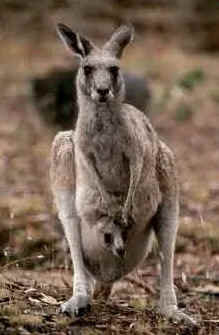I a fifth class student in Portlaw N.S. I am doing a project on Mammals. Here it is.
Human beings are mammals, and so are many of the farm animals and pets they keep. Mammals have warm blood and backbones and the females all feed their newly born young with milk produced in special glands called mammae. Mammals
also have hair, but the quantity of this varies considerably.Some mammals are covered with hair all over while others have hardly any at all. Mammals are divided into three main
groups. The first of these called the egg-laying mammals, contains only two kinds, these strange animals hatch out their young from eggs as bird do and then feed them on milk.The second group is made up of the marsupials, or pouched mammals. Their young are born in a very undeveloped state and are generally less
then an inch long. Among marsupials are the kangaroo, tasmanias devil, flying
phalanger and opossum.
mammals. Their young are born in a very undeveloped state and are generally less
then an inch long. Among marsupials are the kangaroo, tasmanias devil, flying
phalanger and opossum.
The third and largest group is known as the placental mammals. The placenta is an organ which develops inside the mother and from which the growing baby gets its nourishment. After birth, the the placenta also comes away and is therefore known as the afterbirth. The placental mammals are further divided into ten main groups: Insectivores are mostly found in the eastern half of the Northern Hemisphere and in Africa, though there are some in North America. The best known are the moles, shrews and hedgehogs.
 Chiroptera are the
bats. Nearly all the large ones eat fruit and most ones catch insects.
Chiroptera are the
bats. Nearly all the large ones eat fruit and most ones catch insects.
Primates (first) are the lemurs, monkeys, apes and man. They are best described as animals with hands and feet. Edentates (without teeth) include some animals without any teeth at all and others with just a few. The best known kinds are sloth’s, armadillos and ant eaters. Rodents (gnawing animals) are the most numerous of all. There are more than 15,000 kinds of mammals and more than 6,000 of then are rodents. Porcupines, guinea pigs and beavers are rodents, and so rats and mice. Well known land carnivores are lions tigers hyenas
bears and domestic cats and dogs. Carnivores that live in the sea include seals sea-lions and walruses. Cetacea
(Whales) are fish-shaped mammals almost without hair and so adapted to water
life that they are helpless and die if stranded on land. Beside the true whales,
this group includes dolphins and porpoises. The blue whale is the largest living
animal.
Cetacea
(Whales) are fish-shaped mammals almost without hair and so adapted to water
life that they are helpless and die if stranded on land. Beside the true whales,
this group includes dolphins and porpoises. The blue whale is the largest living
animal.
Proboscidea (with a trunk). Today the Indian and African elephants are the only members of this group of plant-eating animal which live in water all their lives. Sirenia
